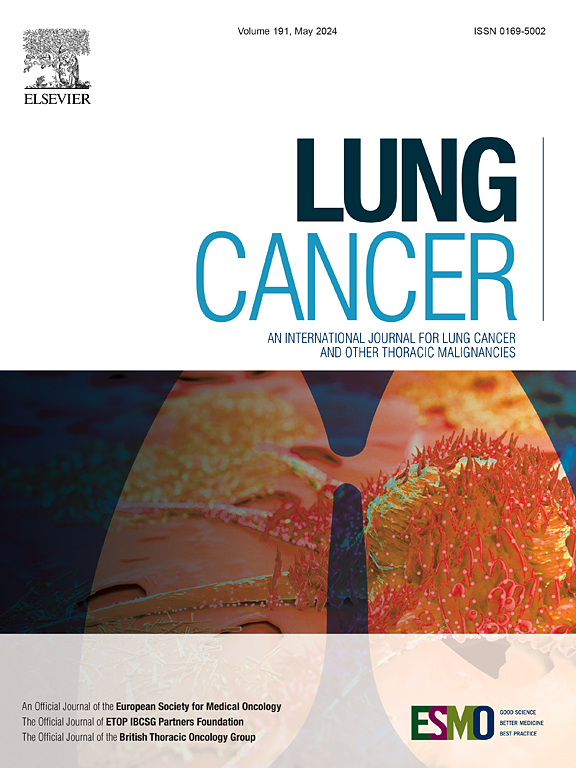形状感应机器人辅助肺部小结节取样的冷冻生物切片检查与细针穿刺术对比。
IF 4.5
2区 医学
Q1 ONCOLOGY
引用次数: 0
摘要
简介形状感应机器人辅助支气管镜(ssRAB)已成为一种很有前途的工具,可提高肺结节(PPN)取样的效果。以前的研究表明,对于不同大小的病灶,1.1 毫米低温探针与细针抽吸(FNA)相比同样有效。我们的目的是比较 1.1 毫米冷冻探针与 FNA 在用 ssRAB 抽取小于 20 毫米的 PPN 时的性能:我们从 2022 年 11 月到 2024 年 2 月对接受 ssRAB 和冷冻活检评估 PPN 的患者进行了一项回顾性队列研究。我们比较了冷冻活检和 FNA 对相同 PPN 的诊断率和恶性肿瘤敏感性。我们使用 McNemar 检验和比例比较法进行了描述性统计分析。多变量逻辑回归评估了PPN特征对每种工具诊断率的影响:我们纳入了 256 名患者,共进行了 284 次手术,采集了 324 个结节样本。结节最大和最小尺寸的中位数分别为 1.6 厘米(IQR 1.17-2.4)和 1.17 厘米(IQR 0.86-1.7)。ssRAB的总体诊断率为93.8%,对恶性肿瘤的敏感性为97.5%。冷冻活组织检查的诊断率为 92%,灵敏度为 96%,FNA 的诊断率和灵敏度分别为 70.4% 和 79.29%(P 结论:冷冻活组织检查的诊断率和灵敏度均高于 FNA:与 FNA 相比,冷冻活组织检查对恶性肿瘤的诊断率和敏感性在统计学上更高。值得注意的是,FNA 对 PPN 的诊断几率较低。本文章由计算机程序翻译,如有差异,请以英文原文为准。
Cryobiopsy versus fine-needle aspiration for shape-sensing robotic-assisted sampling of small lung nodules
Introduction
Shape-sensing Robotic-assisted Bronchoscopy (ssRAB) has emerged as a promising tool for improved performance when sampling pulmonary nodules (PPN). Previous studies suggest that the 1.1 mm cryoprobe is as effective compared to fine needle aspiration (FNA), for different lesions sizes. We aim to compare the 1.1 mm cryoprobe performance to FNA for sampling PPN < 20 mm with ssRAB.
Material and Methods
We conducted a retrospective cohort study from November 2022 to February 2024 of patients who underwent ssRAB with cryobiopsy for evaluation of PPN. We compared the diagnostic yield and sensitivity for malignancy of cryobiopsy and FNA for the same PPN. Descriptive statistical analysis was conducted using the McNemar’s Test and Comparison of proportion. Multivariate logistic regression assessed the impact of PPN characteristics on the yield of each tool.
Results
We included 256 patients, with a combined 284 procedures, and 324 nodules sampled. The median maximum and minimum nodule size was 1.6 cm (IQR 1.17–2.4) and 1.17 cm (IQR 0.86–1.7) respectively. The overall ssRAB diagnostic yield was 93.8 % and sensitivity for malignancy was 97.5 %. Cryobiopsy had a diagnostic yield of 92 % and sensitivity of 96 %, FNA had a 70.4 % and 79.29 % respectively (P < 0.001). Cryobiopsy had a significantly higher performance compared to FNA across the analyzed categories (P < 0.05), except for the sensitivity of mixed-type lesions (P = 0.11). PPN < 10 mm and ≥ 10 mm − <15 mm sampled with FNA, had lower odds of achieving a diagnosis compared to the ≥ 20 mm group (OR = 0.305 IC95%: 0.142–0.65, p < 0.001; OR = 0.497 IC95%: 0.263–0.939, p = 0.031, respectively). Complications occurred in 5.98 % (N = 17) of cases.
Conclusion
Cryobiopsy demonstrates a statistically higher diagnostic yield and sensitivity for malignancy compared to FNA. Remarkably, FNA showed reduced diagnostic odds in PPN < 15 mm. ssRAB with cryobiopsy could enhance PPN diagnostic yield, leading to earlier lung cancer diagnosis and improve long-term survival rates.
求助全文
通过发布文献求助,成功后即可免费获取论文全文。
去求助
来源期刊

Lung Cancer
医学-呼吸系统
CiteScore
9.40
自引率
3.80%
发文量
407
审稿时长
25 days
期刊介绍:
Lung Cancer is an international publication covering the clinical, translational and basic science of malignancies of the lung and chest region.Original research articles, early reports, review articles, editorials and correspondence covering the prevention, epidemiology and etiology, basic biology, pathology, clinical assessment, surgery, chemotherapy, radiotherapy, combined treatment modalities, other treatment modalities and outcomes of lung cancer are welcome.
 求助内容:
求助内容: 应助结果提醒方式:
应助结果提醒方式:


